You have been building an ecommerce business that you’ve put a lot of time, effort, and sweat equity into growing, and now you’re looking to sell. Your objective is to get maximum value and you’re assessing steps to prepare for the sale. There are a multitude of variables to consider and in this post, we’ll cover them all to maximize the price you receive when exiting.
Let’s get right into it.
We Analyzed 115 Sales: Here’s What We Found
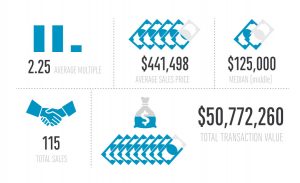
Some interesting things we found:
- -The average multiple (2.25)
- -There where more transactions in the $0-$250k range, this is reflective of the mode (most frequent) being higher for eCommerce businesses compared to all internet businesses
- -Larger businesses ($5 million plus) still commanded the highest multiple
- -Dropship sites commanded a lower multiple
- -Seems that it’s harder to grow a dropship website over $1 million in sales
What Are The Market Trends?
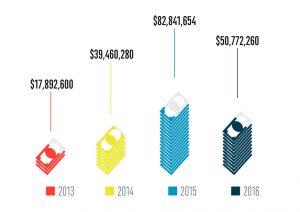
On a total deal transaction volume basis, we can see that between 2014 and 2015 the total businesses sold doubled. 2016 took a slight downturn but I forsee an uptick for 2017.
What Has the Average Sales Multiple Been Per Year?
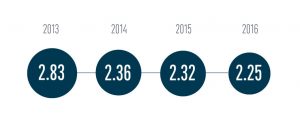
E-commerce businesses can sell for as little as a few thousand dollars to hundreds of millions if not billions of dollars. This graph shows the data we analyzed which are typically businesses in the $100 thousand to $10 million valuation range. As we can see the average has been sitting around 2.30 times earnings for the past two years. I think there has been a drop in the average multiple slightly because there has been more supply of e-commerce businesses on the market.
Are Small Or Larger Businesses Worth More?
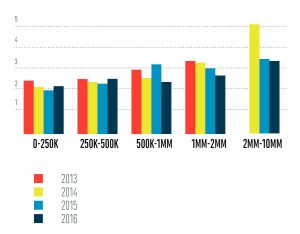
Surprisingly there is a large portion of sales in the $200k-$500k range. In each of our reports, we have seen a large proportion of sales pushed towards the lower end of the spectrum in the sub $200k range. A guess at why this is happening is because of the large transaction value of eCommerce stores. This graph represents gross sale price so that might mean it is easy to grow an eCommerce store a few hundred thousand dollars per year in gross sales.
What Size Store is Worth More?
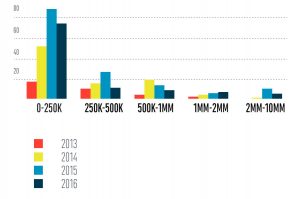
In general, the larger the e-commerce business, the more that it is worth. Here is how you understand this graph below. Let’s say that a business sold for $75,000. On average that would mean that it’s yearly profit was $32,500 ($75,000 divided by 2). Another example would be a business that sold for $500,000. On average that would mean that it’s yearly profit was $208,000 ($500,000 divided by 2.4). Similarly, a business that sold for $4 million or on average that would mean that it’s yearly profit was $1.2million ($4 million divided by 3.3)
From the data you can see that multiples averaged similar prices for each valuation bracket between 2013 and 2015.
Where Were the Sales Distributed?
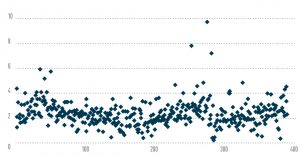
This graph represents the distribution of the sales.
What is the selling process?
The selling process is fairly straight forward but can be more complex and take more time depending on the size of the business. In general, most sales will be structured like this:
- You decide to sell
- You get a valuation of your business
- You develop a prospectus (all the facts and figures about your business)
- Find potential buyers for your business
- Negotiate a price with potential buyers (total price and also terms of the deal)
- Due Diligence – buyer verify’s all the financials of the business
- Transfer of the assets & money
- Help train the new buyer to run your business
What is the value of your inventory?
How do you value my inventory?
Inventory is required to run your business. It is customary to include a normal inventory level in the purchase price of a business that can sustain current revenues being generated by the business. Therefore everything over that amount is to be purchased by the buyer in addition to the business valuation. The following will generally happen when considering inventory:
1) Prior to closing the sale, an inventory count is taken and the sale price is adjusted, up or down, from the amount included in the sale price.
2) Inventory is valued at cost. If the inventory is significantly higher than the normal level, will a price over that level will be negotiated?
3) A decision needs to be made whether the cost of the inventory is to be determined by using the original invoice, a percent of retail price, or a professional inventory firm.
4) Not all inventory is created equal. Aged, broken or obsolete inventory will be determined if it is sell-able and the price negotiated appropriately. This mainly comes as discounting a portion of the inventory but can also be the seller financing a portion and the buyer paying for it only when it sells.
How do I increase the value of my business before selling?
If you can achieve the following you will be able to increase the value of your business.
- Predictable key drivers of new sales
- Stable or growing traffic from diversified sources
- Established suppliers of inventory with backup suppliers in place
- Traffic stats (Google Analytics or other) with a long history
- High percentage of repeat sales
- High percentage of repeat visitors
- Clean legal history
- Brand with no trademark, copyright or legal concerns
- Documented systems and processes
- Growth potential
Where Can You Sell Your Business? The Best Ecommerce Business Brokers
Small Business Marketplaces – (under $100k)
Smaller business and micro-businesses are usually best sold privately by the owner through forums or classified websites.
To sell your small business, check out:
Broker – ($100k – $20m)
Medium sized businesses in the $100k-$20m are best sold through brokers who help with finding buyers, negotiating and structuring the deal. To sell your medium sized business, check out:
Investment Banks – ($20m +)
Larger businesses are best sold through investment banks or merger and acquisition companies. To sell your large business, check out:
- Business Exits – great if your business is making over $4m dollar profit per year.
How much will it cost to sell my business?
Generally a business broker will charge 10-12% of the sales price of an eCommerce business including inventory.
How long will it take to sell my business?
